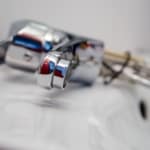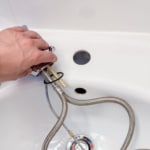Your Faucet Is Broken off? Causes, Solutions & Interesting Facts
If a faucet breaks off, it is usually due to lime deposits that have built up over the years.
This makes the material porous, so that at some point one vigorous movement is enough to tear off the faucet.
Also angle valves that are rarely used can break off if they are turned with a jerk – it is particularly annoying if a piece of the connecting pipe gets stuck in the thread.
In this article, we will tell you how to proceed with these problems and who has to pay for repairs in rental apartments.
Contents
What to do if the faucet has broken off
If the faucet has broken off, the first thing to do is turn off the water.
To do this, turn the corresponding angle valve under the sink in the bathroom/kitchen to the right.
Alternatively, you can turn off the water for the entire household using the main shutoff valve. This is usually located in the basement.
Now it’s best to go to the nearest hardware store, with the broken faucet, to find a replacement that has the right size.
It is important to know whether you are using a high or low pressure fitting. In the latter case you must not screw on a faucet with a perlator, for example.
The fitting type is written on the packaging. Find out in our separate article how you can easily identify low pressure fittings.
The replacement of a fitting
If only the curved spout of the faucet has broken off, it is sufficient to screw in a replacement.
If a piece of the outlet is still stuck in the thread and cannot be unscrewed, you will find out how to proceed further down in this article.
To replace the entire fitting, proceed as follows:
- Turn off the water using the angle valves or the main valve.
- Open the faucet to allow excess water to drain.
- Unscrew the hoses of the fitting from the angle valves and, if necessary, the boiler. It is best to have a towel ready to catch any remaining water from the pipes.
- Loosen the screw connection on the underside of the sink. Now you can pull the fitting upwards.
To assemble your new fitting, simply go through these steps in reverse order.
Here is a video of the procedure just described:
Mixing lever broken
If the handle of your one-lever mixer breaks off, it was likely already porous. Especially with cheap fittings that are already dripping and squeaking, it is only a matter of time before they break off.
Whether you can replace the lever or have to buy a completely new fitting depends primarily on the manufacturer. In the case of cheap models, it may well be that no spare parts are available.
You should also check whether only the lever or also the cartridge underneath is damaged. In the latter case, it must of course also be replaced so that the lever holds.
Faucet/angle valve broken off in the thread
This problem can occur when replacing angle valves, but also with ball valves for external connections and washing machines.
Potentially, you want to unscrew it from the thread in the wall and replace it. Even with the use of force, the pipe does not move at all – until it finally breaks off.
If you are unlucky, the pipe has broken off so badly that a piece of the nipple is still stuck in the thread. This is annoying, but no reason to despair: There are several ways to get such a piece of pipe out again:
1. If the broken off piece is not deep in the thread, you can try a ratchet or an open-end wrench with a suitable socket to get it out. The pipe section might be unscrewed in this way.
2. Alternatively, take a thin chisel and place it on the stuck piece of pipe.
Carefully hit the chisel in the direction to unscrew the direction to unscrew (usually counterclockwise) so that the piece loosens. Do not use too much force to avoid damaging the thread.
Caution: Make sure beforehand that the pipe is firmly anchored. If you hammer it into the wall, you will have great problems getting it out.
3. You can also take a thin saw blade and saw the length of the pipe from the inside. You should now be able to bend it and take it out with a screwdriver.
But be careful: with thin pieces of pipe, you run the risk of damaging the thread.
4. If conventional tools fail, you can buy a suitable screw extractor and use it to remove the pipe section.
Insert the screw extractor into the thread so that it attaches to the pipe section. If necessary, tap it gently with a hammer.
You can then remove the remaining piece by turning it counterclockwise. A pair of pliers or a wrench can be used for this.
A tip: Even if the pipe section does not seem to move, you should not use too much force. Instead, spray it with rust remover and wait a while before applying the tool.
How do I replace a broken faucet or angle valve?
Once you have removed the piece of pipe from the thread, you can start the replacement.
Regardless of whether it is an angle valve, a water connection in the shower or a ball valve – before you screw in the replacement part, you have to roughen and seal the thread on the nipple.
The roughening is done like this:
Take a saw blade and run it several times over the nipple of the pipe at a 45° angle. While doing this, turn the pipe until you have roughened the entire surface.
There are two ways to seal the nipple: Teflon tape and hemp.
Sealing with Teflon tape
This method is less demanding and therefore the best choice for beginners – even if it is not as sustainable as sealing with hemp.
- First make sure that there is no glue residue or other contamination on the thread.
- Check to see if it is a right or left hand thread.
- Pull the Teflon tape tight and flush onto the thread in the direction of rotation. Depending on the length of the thread, 2–4 turns are sufficient.
- Tear off the Teflon tape (as with scotch tape) and twist the wrapping with your hand until it is as tight as possible. The thread should be clearly visible under the Teflon tape.
Sealing with hemp
This classic method takes some practice. If you do it correctly, the thread will hold tight for decades.
For sealing you need:
- Sealing hemp
- A steel brush
- Neo Fermit paste
1. Tear off a piece of hemp cord – a little too much rather than too little.
2. Place the hemp on the front of the thread and wrap it tightly in the direction of rotation (mostly clockwise) until the hemp holds by itself. If it loosens, go with a wire brush in the direction of rotation over the hemp on the thread.
3. Then apply the Neo Fermit paste evenly with your finger to the thread to further improve the seal.
By the way: If you attach an angle valve or a ball valve with a ceramic seal, you save yourself the sealing.
Here is a short video guide for the procedure just described:
Faucet broken off – who pays?
If you rent your home and your faucet has broken off, the question arises of who will pay for the costs for materials and repairs. It depends on who or what caused the damage.
Note that these rules and laws will also vary from country to country. The following information is an example based on tenancy laws in Germany.
In the event of damage caused by natural wear and tear, the landlord must bear the costs.
This is the case, for example, when a faucet has become so porous through years of lime deposits that it breaks off at some point even if just turning it with little force.
The situation is different if the damage was caused by the tenant, e.g. tearing too violently.
Also pay attention to the small repairs clause contained in many rental agreements.
This states that the tenant is responsible for damage to frequently used objects, as long as a certain cost limit is not exceeded. This limit must be expressly set out in the rental agreement.
The upper cost limit for individual repairs is often set at 90–150 €. An upper limit for minor repairs must also be set for the whole year: 8% of the annual rent excluding incidental costs is the norm.
Again, make sure to check the specific laws in your country. This resource may help you to get started with the research regarding the relevant laws in the U.S.
Sharing is caring 🙂 !
[addtoany]




